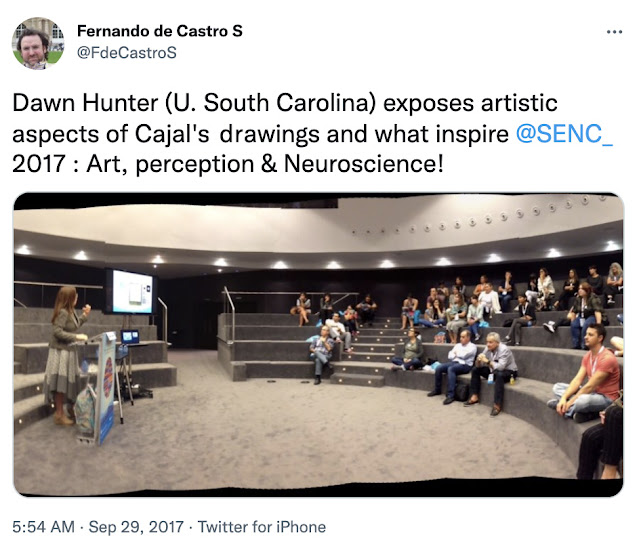The social media art challenge prompts are an excellent way for artists to express themselves, let their creativity flow, and get their work out there. Prompts are usually keywords, which can be anything from a single word to a sentence. I have a couple of favorites that I follow and participate in during the month of October; Facetober and Peachtober. During 2021, I created the Darcy Inventory based on the Facetober prompts and that series has gone on to be included in professional art exhibitions, like ArtFields.
The Facetober challenge is created by a Skillshare top teacher, British designer and illustrator Charly Clements. The prompts Charly creates helps people find new ways of self-expression through short-form portraits. This is an excellent opportunity for artists who prefer drawing or painting people instead of landscapes or other subjects to showcase their skills.
Sha'an d'Anthes, an illustrator, artist, and author, created the social media art challenge Peachtober. She is the creator of the highly engaged Instagram account @furrylittlepeach, which features many of her creative projects, reels, and sneak peeks into her studio. The challenge for Peachtober is open-ended one word prompts, with various concepts and subjects that can be experimented with for the month.
If you are looking for social media engagement and connections with other artists while expanding your studio practice, both Facetober and Peachtober are excellent choices.
Sha'an d'Anthes and Charly Clements do a great job sharing their social media prompt schedule a month before the challenge starts. This gives artists plenty of lead time to gather their materials, think through the concepts, plan their work, and create artworks before the challenge starts.
Making your artwork ahead of time is crucial because it grants you the opportunity to copyright your artwork in batches, which is cheaper than copyrighting a single artwork ($65.00 per single work registration vs. $65.00 per group registration).
Original artwork posted on social media is a very popular form of expression, however before posting your artwork online, you should always make sure that you have copyright protection. Filing a copyright registration prior to publication also entitles you to a greater award sum for damages if an infringement occurs.
It might sound complicated, it is much simpler than you think.
What is Copyright?
"Copyright is a form of protection for the rights of creators of works. It is used to give them the sole right to reproduce, distribute and create derivative works from their original work." -www.copyright.gov
Copyright is not a new idea, it has been around since the 18th century. It was first established in England in 1710 by the Statute of Anne. The United States followed suit with the Copyright Act in 1790 which has been updated over time to reflect changes in technology and society.
What's the Difference Between Copyright and Public Domain?
"Copyright is a form of protection grounded in the U.S. Constitution and granted by law for original works of authorship fixed in a tangible medium," such as writing, music, or artwork. Copyright covers both published and unpublished works.
Public domain is the legal status of creative works that are not subject to copyright or similar rights of protection. These include ideas, facts and discoveries; news events; government publications; works created by U.S. federal "government employees as part of their official duties;" and anonymous or pseudonymous works (unless the author's identity is generally known or can be reasonably ascertained).
Copyright protects original work from being used without permission from its owner - this includes copying, modifying, distributing, displaying publicly and making adaptations from it. The public domain does not offer any protection to a work - anyone can use it without permission from the author which includes copying, modifying, distributing, displaying publicly, and making adaptations from it.
An image that is posted publicly on the internet is not automatically public domain. Most people only realize they have committed copyright infringement when they are being arrested. It is important to determine authorship and receive permission to post images that you have not created. That is a topic that will be developed further in another blog post; however, I want to touch on it briefly here.
How to Register Multiple Artworks with One Application
The Copyright Office offers a way for creatives to register their individual works as a collective or compilation. The Copyright Office allows a group registration for up to ten works in one registration application.
You will need documentation of your photo, artwork, or illustration. Additionally, you will need an online eCO registration account through the U.S. Government Copyright Office, a completed online form, and a means of payment.
If your application is approved, you will be entitled to seek one award of statutory damages for the collective work as a whole, rather than a separate award for each individual work, even if the defendant infringed all of those works.
How to Copyright Your Artwork in Batches of Ten
As an artist, you're likely constantly crafting new pieces of art. You might wonder if there's a way to copyright your artwork in groups of up to ten works at once. Good news! It's totally doable and pretty simple.
Here's the catch: for works of art to be eligible, your artwork shouldn't have been published prior to your registration application.
Review and follow the steps below, and your work will be protected at a cost-efficient price.
1. Create an eCO account.
Protecting your intellectual property is important for professional success. Remember to procure copyrights and trademarks for all of your art, products, services, and branding. Protecting intellectual property with copyrights and trademarks can be time-consuming, but it's worth it. The US Copyright Office website provides excellent resources for individuals: www.copyright.gov.
2. Select "Register a Group of Unpublished Works."
You can make the process easier by copyrighting your artwork in batches of up to ten works. For a social media challenge like, Facetober, I would recommend to register each week as a batch, especially since the prompts are organized in that manner. That would be a total of four batches and the total cost would be $260.00. If you were to registered all thirty-one works individually, the total cost would be $2,015.00.
You'll need the work's title, the year it was created, and the copyright owner. The US Copyright Office will assign you a number once you've filed your application.
3. Complete the online form prompts:
- Type of Work
- Title of Work
- Completion
- Authors/Claimants
- Limitation of Claim
- Rights and Permissions
- Correspondent
- Mail Certificate
- Special Handling
- Certification
- Review Submission
6. After your payment clears, double-check your application, upload any needed docs, and submit.
It'll take about 60 days for the review process, but your work will be protected once you've registered! If you work with an intellectual property lawyer, share your registration and certificate with them.
Got questions? Reach out to the copyright office!
It's a relief to have your work registered with a copyright. It is a topic that I feel passionate about, and you can learn more about how to register an individual work in my blog post from February 2022 titled Your Cheatin' Heart.











